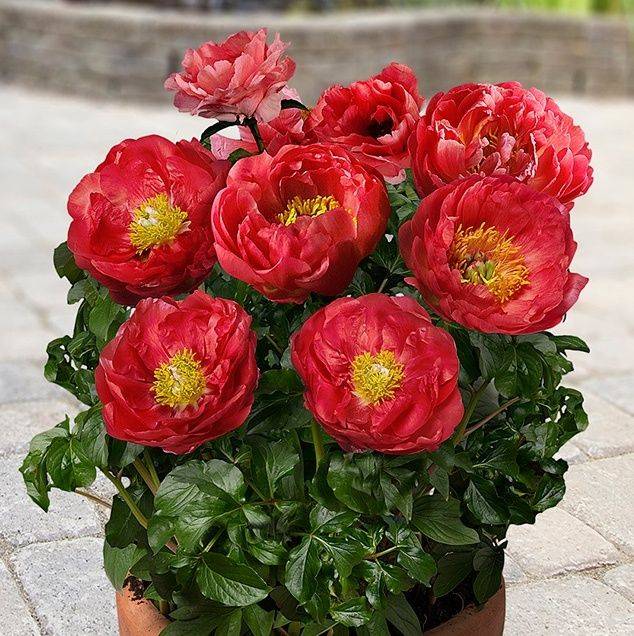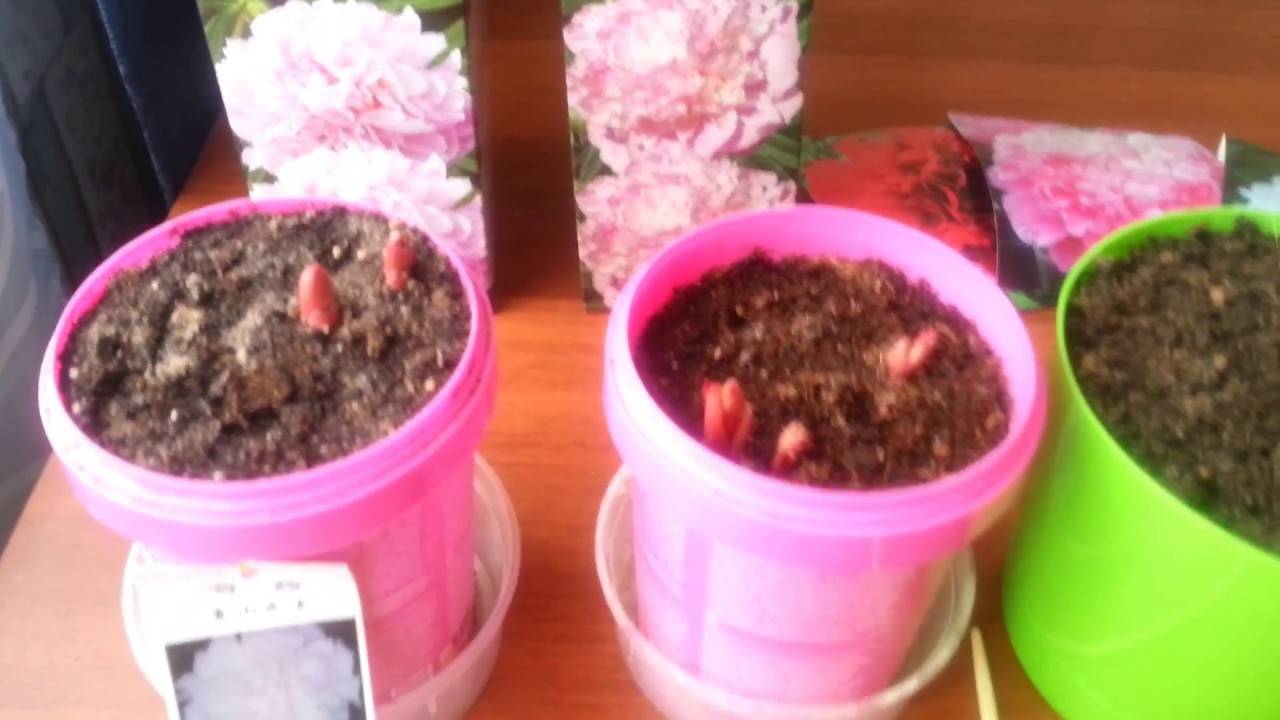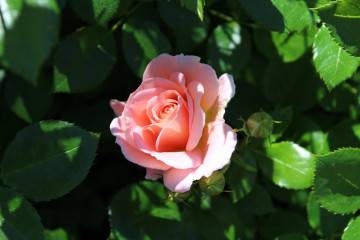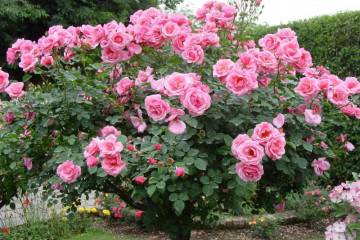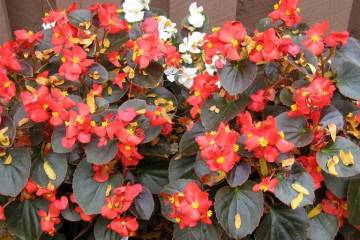Potted peonies - features of growing ornamental plants
Content:
Some garden plants can withstand growing at home. Among them, peonies (from the lat. "Paeonia") occupy an honorable place. With the right care, they can grow healthy and bloom well. Below is a detailed description of the choice of a place in the apartment, feeding flowers and the necessary conditions for their development.
What is the difference between the root system of peonies
The underground part of the peony is represented by a thick tuber; it stores substances for the development and life of the plant. Formed from adventitious roots of medium thickness. Another area of this system is the small white suction roots. They nourish and fill the flower with moisture, die off every year.

Low-growing peonies in a pot feel great, the main condition for their flowering is feeding, watering, protection from drafts
Is it difficult to transplant a peony
A flower is transplanted when it becomes large, it grows. Thin roots sit firmly in the ground. It is very difficult to pull the plant out without damage. But this can be done, you must adhere to the rules of planting a peony.
How does a plant feel in an apartment or on a balcony
Peony is a light-loving plant. They put it on the windowsill on the south, southeast side of the apartment. In dark rooms, additional lighting is turned on for 12-13 hours a day, and the phytolamp is removed in the evening.
The plant does not tolerate drafts, so you should not keep the window open. When airing the room, the pot is removed from the window. He does not like shrubs and dry air, you need to find a place for it away from heating appliances.
What varieties of peony can be grown at home
Homemade peonies are bred in a pot, choosing suitable for this variety. The most famous are:
- Moscow is a dwarf species, the bush reaches 35 cm. Red flower 5-10 cm in diameter with bright yellow stamens. Flowering time is early summer. Unpretentious, does not like a lot of water, watering is recommended in moderation;
- London. It reaches a height of up to 20 cm. A bush with large buds. Suitable for planting indoors, on balconies, in open ground. Blooms in May;
- Rome grows up to 50 cm in length and blooms in June. Gathers buds of a pale pink shade. The flower diameter is 7-10 cm;
- Oslo is a herbaceous peony, flowering in early June - July. Height 50-55 cm. Hibernates without shelter, unpretentious appearance;
- Zhu Sha Pan is easy to care for, not capricious flower, but does not like drafts.
Landing rules
Planting time for peonies is the beginning of spring. A bush planted with violations will be weak, it will not be able to give abundant flowering. First of all, you need to choose the right dishes, since the roots of the plant are powerful, they cannot develop in unsuitable pots.
Choice of dishes
For breeding indoor peonies in a pot, containers with a volume of at least 5 liters 40-45 cm high are selected. The diameter of the dishes must be at least 25 cm. The bottom of the container should have small holes for draining excess liquid. They use classic options:
- plastic;
- ceramic vases;
- glass.
Preparing seedlings for planting
When buying a seedling, you must carefully check the condition of the stem and roots. In the presence of rotten areas, mold on the tuber, the cutting should be discarded. If the plant has already been purchased and damaged due to improper storage by the owner himself, cut off the excess part with pruning shears or garden shears. Cuts are made obliquely, sprinkled with wood ash. To grow peonies at home, the seedlings should be treated with a potassium permanganate solution for disinfection.
Buds (1 or 2) should hatch on the delenka. In the absence of development of eyes, the cutting is sent to the refrigerator. When bud growth is outlined, the plant is planted after pretreatment.
Preparation or selection of soil mixture
Potash fertilizer combined with nitrogen will help the plant to root quickly. The shrub does not like acidic soil; peat is not used as a fertilizer. It is necessary to measure the state of the earth, the reaction of the medium should be within the pH range 6.5-7.0.
When self-preparing the soil, vermiculite (2 cups), bone meal (2 tablespoons), as well as phytosporin (1 teaspoon) are added to the mixture with biohumus (5 liters).
Step-by-step instructions for planting in a pot
When planting a peony in a pot, follow these steps:
- The bottom of the pot is covered with drainage (ready-made or use sand, pebbles).
- Pour the prepared soil mixture.
- Water abundantly, mix. The ground should be moist enough.
- Lay the tuber buds up.
- Sprinkle.
- Water the top layer of the soil.
What conditions must be observed when caring for a decorative peony
For good growth, lush flowering, perennials need suitable conditions. Pay attention to the following points:
- temperature;
- watering, humidity level;
- lighting;
- the use of fertilizers.
Temperature
In a very warm room, the peony stops rooting. Recovers at a temperature of 10-15 ° C. The plant overwinters at 5-8 ° C.
Watering and moisture
The perennial is watered with water at room temperature with a dried surface of the earth up to 1.5-2 cm. The liquid is distributed over the entire surface of the container, the flowers cannot stand abundant watering. Remaining moisture must escape through the drain hole. At the end of summer, the frequency of watering is reduced: they wait for the soil to dry completely in the dishes, then they only moisten the soil.
Lighting
For the development of inflorescences, the lightest place for peonies in the apartment is allocated. The south side of the room works well. It is not always possible to find a sufficiently illuminated place, in which case the LED phytolamp helps out lovers of peonies. Due to the light spectrum, active growth is ensured. The device can be brought close enough to the leaves, the LED has a low voltage, which increases its safety when water hits the body. The time for using artificial lighting is shortened at the end of August, since preparations for the dormant period begin in this month.
Top dressing
When the first stalks appear, the soil is fertilized. The plant is fed once every 30 days. To do this, use prepared mixtures for perennial flowers, feeding stops at the beginning of autumn. Ash, sand are used as protection against mold; ready-made fertilizers with nitrogen are selected in flower shops. During the ripening period of the buds, potassium is added to the ground, as well as phosphorus.When the shoots reach 10 cm in height, fertilizing is applied once every 14 days.
How to care for a peony in winter
In winter, reduce the frequency of watering. Place the pot in a cooler and less lit place. This is done in order not to provoke the beginning of the growing season. The flower is left dormant for the winter.
Is it possible to transplant an indoor peony to the street
For transplanting into open ground, indoor peonies must be trained. In the fall, the seedlings are placed in a pot, observing dormant conditions. At the beginning of spring, the plant is added dropwise along with the container. At the end of August, they are transferred to the ground.
Lush bright red or pale pink peony buds can please the eye not only in the garden. The plant is easy to plant and leave, you just need to create the conditions necessary for its development.
